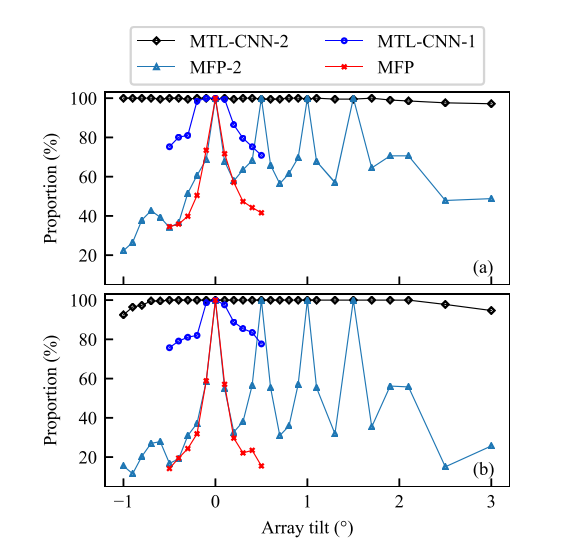Machine learning has been used in underwater acoustic source localization in recent years. When researchers use the observation data as the training data, the obtained models could achieve superior results over conventional matched field processing (MFP). However, collecting the observed data is difficult in some scenarios, thus limiting the application of machine learning. Some studies focus on training machine learning models using the synthetic data calculated by acoustic propagation models. However, the mismatch between model generated data and measurements caused by uncertain environments is still a challenge.
Recently, researchers from the Institute of Acoustics of the Chinese Academy of Sciences (IACAS) proposed a passive source localization method based on multi-task learning (MTL) suitable for mismatched environments.
In the method, researchers used a single convolutional neural network (CNN) trained on synthetic data to realize the range and depth estimation sound sources in a mismatched environment. They used an adaptively weighted loss to weight the loss functions of range and depth estimation. To handle the environmental uncertainty, the validation data were generated by an acoustic propagation model based on multiple possible sets of environmental parameters.
The sensitivity analysis demonstrated that, compared with the conventional MFP, the CNN with MTL performed better and was more robust to array tilt in the deep-ocean environment. To further alleviate the effect of array tilt, simulated data with different array tilt of coarse grid were added into the training data. Simulation results showed that the method was robust to array tilt.

Figure 1. The comparison of sensitivity of different methods to array tilt: (a) range estimations; (b) depth estimations. (Image by IACAS)
The approach was also tested on the experimental data collected in a sea experiment in 2016. There were 486 signals along the track with source range 1~57 km. Compared with the MFP, the proposed method reliably estimated the ranges and depths of the underwater acoustic source in the specific ranges where the MFP failed, showing the validation of the method in mismatched environment.

Figure 2. The comparison of MTL and MFP: (a) range estimations; (b) depth estimations. (Image by IACAS)
The array tilt was the most important factor in localization. To reduce the effect of array tilt mismatch on localization, the training set could be enlarged by including more simulation data with multiple array tilts. The error statistics showed that 92.8% range predictions had a relative error below 10% and the error of 86.2% depth estimates was within 20 m.
The research, published online in the Journal of the Acoustical Society of America, was supported by the National Natural Science Foundation of China (No.11434012, No.11874061).
Reference:
LIU Yining, NIU Haiqiang, LI Zhenglin. Block sparse Bayesian learning for broadband mode extraction in shallow water from a vertical array. Journal of the Acoustical Society of America, vol. 148, no. 2, pp. 873-883, August 2020. DOI: 10.1121/10.0001762.
Contact:
ZHOU Wenjia
Institute of Acoustics, Chinese Academy of Sciences, 100190 Beijing, China
E-mail: media@mail.ioa.ac.cn


